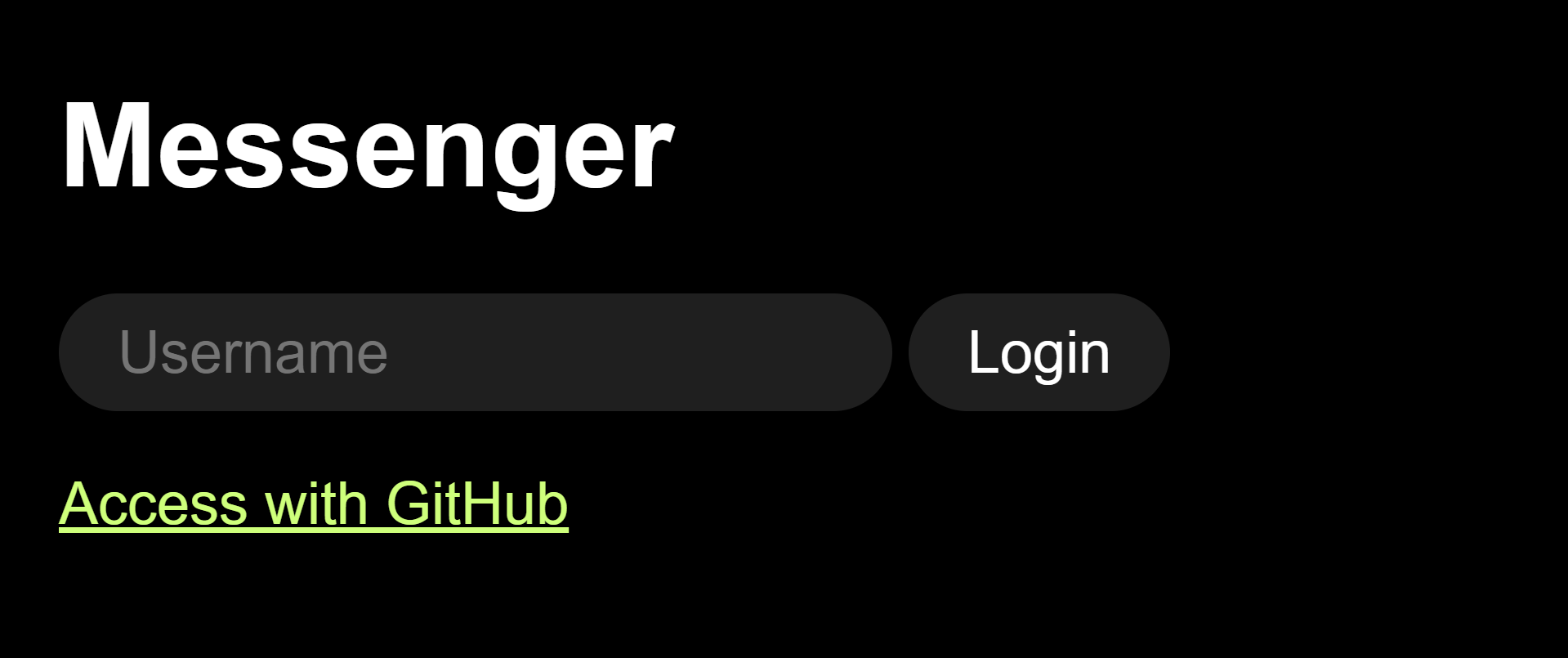构建一个即时消息应用(七):Access 页面
译自:https://nicolasparada.netlify.com/posts/go-messenger-access-page/
作者: Nicolás Parada
原创:LCTT https://linux.cn/article-12704-1.html
译者: XianLei Gao

本文是该系列的第七篇。
现在我们已经完成了后端,让我们转到前端。 我将采用单页应用程序方案。
首先,我们创建一个 static/index.html 文件,内容如下。
<!DOCTYPE html> <html lang="en"> <head> <meta charset="utf-8"> <meta name="viewport" content="width=device-width, initial-scale=1.0"> <title>Messenger</title> <link rel="shortcut icon" href="data:,"> <link rel="stylesheet" href="/styles.css"> <script src="/main.js" type="module"></script> </head> <body></body> </html>
这个 HTML 文件必须为每个 URL 提供服务,并且使用 JavaScript 负责呈现正确的页面。
因此,让我们将注意力转到 main.go 片刻,然后在 main() 函数中添加以下路由:
router.Handle("GET", "/...", http.FileServer(SPAFileSystem{http.Dir("static")})) type SPAFileSystem struct { fs http.FileSystem } func (spa SPAFileSystem) Open(name string) (http.File, error) { f, err := spa.fs.Open(name) if err != nil { return spa.fs.Open("index.html") } return f, nil }
我们使用一个自定义的文件系统,因此它不是为未知的 URL 返回 404 Not Found,而是转到 index.html。
路由器
在 index.html 中我们加载了两个文件:styles.css 和 main.js。我把样式留给你自由发挥。
让我们移动到 main.js。 创建一个包含以下内容的 static/main.js 文件:
import { guard } from './auth.js' import Router from './router.js' let currentPage const disconnect = new CustomEvent('disconnect') const router = new Router() router.handle('/', guard(view('home'), view('access'))) router.handle('/callback', view('callback')) router.handle(/^\/conversations\/([^\/]+)$/, guard(view('conversation'), view('access'))) router.handle(/^\//, view('not-found')) router.install(async result => { document.body.innerHTML = '' if (currentPage instanceof Node) { currentPage.dispatchEvent(disconnect) } currentPage = await result if (currentPage instanceof Node) { document.body.appendChild(currentPage) } }) function view(pageName) { return (...args) => import(`/pages/${pageName}-page.js`) .then(m => m.default(...args)) }
如果你是这个博客的关注者,你已经知道它是如何工作的了。 该路由器就是在 这里 显示的那个。 只需从 @nicolasparada/router 下载并保存到 static/router.js 即可。
我们注册了四条路由。 在根路由 / 处,我们展示 home 或 access 页面,无论用户是否通过身份验证。 在 /callback 中,我们展示 callback 页面。 在 /conversations/{conversationID} 上,我们展示对话或 access 页面,无论用户是否通过验证,对于其他 URL,我们展示一个 not-found 页面。
我们告诉路由器将结果渲染为文档主体,并在离开之前向每个页面调度一个 disconnect 事件。
我们将每个页面放在不同的文件中,并使用新的动态 import() 函数导入它们。
身份验证
guard() 是一个函数,给它两个函数作为参数,如果用户通过了身份验证,则执行第一个函数,否则执行第二个。它来自 auth.js,所以我们创建一个包含以下内容的 static/auth.js 文件:
export function isAuthenticated() { const token = localStorage.getItem('token') const expiresAtItem = localStorage.getItem('expires_at') if (token === null || expiresAtItem === null) { return false } const expiresAt = new Date(expiresAtItem) if (isNaN(expiresAt.valueOf()) || expiresAt <= new Date()) { return false } return true } export function guard(fn1, fn2) { return (...args) => isAuthenticated() ? fn1(...args) : fn2(...args) } export function getAuthUser() { if (!isAuthenticated()) { return null } const authUser = localStorage.getItem('auth_user') if (authUser === null) { return null } try { return JSON.parse(authUser) } catch (_) { return null } }
isAuthenticated() 检查 localStorage 中的 token 和 expires_at,以判断用户是否已通过身份验证。getAuthUser() 从 localStorage 中获取经过身份验证的用户。
当我们登录时,我们会将所有的数据保存到 localStorage,这样才有意义。
Access 页面

让我们从 access 页面开始。 创建一个包含以下内容的文件 static/pages/access-page.js:
const template = document.createElement('template') template.innerHTML = ` <h1>Messenger</h1> <a href="/api/oauth/github" onclick="event.stopPropagation()">Access with GitHub</a> ` export default function accessPage() { return template.content }
因为路由器会拦截所有链接点击来进行导航,所以我们必须特别阻止此链接的事件传播。
单击该链接会将我们重定向到后端,然后重定向到 GitHub,再重定向到后端,然后再次重定向到前端; 到 callback 页面。
Callback 页面
创建包括以下内容的 static/pages/callback-page.js 文件:
import http from '../http.js' import { navigate } from '../router.js' export default async function callbackPage() { const url = new URL(location.toString()) const token = url.searchParams.get('token') const expiresAt = url.searchParams.get('expires_at') try { if (token === null || expiresAt === null) { throw new Error('Invalid URL') } const authUser = await getAuthUser(token) localStorage.setItem('auth_user', JSON.stringify(authUser)) localStorage.setItem('token', token) localStorage.setItem('expires_at', expiresAt) } catch (err) { alert(err.message) } finally { navigate('/', true) } } function getAuthUser(token) { return http.get('/api/auth_user', { authorization: `Bearer ${token}` }) }
callback 页面不呈现任何内容。这是一个异步函数,它使用 URL 查询字符串中的 token 向 /api/auth_user 发出 GET 请求,并将所有数据保存到 localStorage。 然后重定向到 /。
HTTP
这里是一个 HTTP 模块。 创建一个包含以下内容的 static/http.js 文件:
import { isAuthenticated } from './auth.js' async function handleResponse(res) { const body = await res.clone().json().catch(() => res.text()) if (res.status === 401) { localStorage.removeItem('auth_user') localStorage.removeItem('token') localStorage.removeItem('expires_at') } if (!res.ok) { const message = typeof body === 'object' && body !== null && 'message' in body ? body.message : typeof body === 'string' && body !== '' ? body : res.statusText throw Object.assign(new Error(message), { url: res.url, statusCode: res.status, statusText: res.statusText, headers: res.headers, body, }) } return body } function getAuthHeader() { return isAuthenticated() ? { authorization: `Bearer ${localStorage.getItem('token')}` } : {} } export default { get(url, headers) { return fetch(url, { headers: Object.assign(getAuthHeader(), headers), }).then(handleResponse) }, post(url, body, headers) { const init = { method: 'POST', headers: getAuthHeader(), } if (typeof body === 'object' && body !== null) { init.body = JSON.stringify(body) init.headers['content-type'] = 'application/json; charset=utf-8' } Object.assign(init.headers, headers) return fetch(url, init).then(handleResponse) }, subscribe(url, callback) { const urlWithToken = new URL(url, location.origin) if (isAuthenticated()) { urlWithToken.searchParams.set('token', localStorage.getItem('token')) } const eventSource = new EventSource(urlWithToken.toString()) eventSource.onmessage = ev => { let data try { data = JSON.parse(ev.data) } catch (err) { console.error('could not parse message data as JSON:', err) return } callback(data) } const unsubscribe = () => { eventSource.close() } return unsubscribe }, }
这个模块是 fetch 和 EventSource API 的包装器。最重要的部分是它将 JSON web 令牌添加到请求中。
Home 页面

因此,当用户登录时,将显示 home 页。 创建一个具有以下内容的 static/pages/home-page.js 文件:
import { getAuthUser } from '../auth.js' import { avatar } from '../shared.js' export default function homePage() { const authUser = getAuthUser() const template = document.createElement('template') template.innerHTML = ` <div> <div> ${avatar(authUser)} <span>${authUser.username}</span> </div> <button id="logout-button">Logout</button> </div> <!-- conversation form here --> <!-- conversation list here --> ` const page = template.content page.getElementById('logout-button').onclick = onLogoutClick return page } function onLogoutClick() { localStorage.clear() location.reload() }
对于这篇文章,这是我们在 home 页上呈现的唯一内容。我们显示当前经过身份验证的用户和注销按钮。
当用户单击注销时,我们清除 localStorage 中的所有内容并重新加载页面。
Avatar
那个 avatar() 函数用于显示用户的头像。 由于已在多个地方使用,因此我将它移到 shared.js 文件中。 创建具有以下内容的文件 static/shared.js:
export function avatar(user) { return user.avatarUrl === null ? `<figure class="avatar" data-initial="${user.username[0]}"></figure>` : `<img class="avatar" src="${user.avatarUrl}" alt="${user.username}'s avatar">` }
如果头像网址为 null,我们将使用用户的姓名首字母作为初始头像。
你可以使用 attr() 函数显示带有少量 CSS 样式的首字母。
.avatar[data-initial]::after { content: attr(data-initial); }
仅开发使用的登录

在上一篇文章中,我们为编写了一个登录代码。让我们在 access 页面中为此添加一个表单。 进入 static/ages/access-page.js,稍微修改一下。
import http from '../http.js' const template = document.createElement('template') template.innerHTML = ` <h1>Messenger</h1> <form id="login-form"> <input type="text" placeholder="Username" required> <button>Login</button> </form> <a href="/api/oauth/github" onclick="event.stopPropagation()">Access with GitHub</a> ` export default function accessPage() { const page = template.content.cloneNode(true) page.getElementById('login-form').onsubmit = onLoginSubmit return page } async function onLoginSubmit(ev) { ev.preventDefault() const form = ev.currentTarget const input = form.querySelector('input') const submitButton = form.querySelector('button') input.disabled = true submitButton.disabled = true try { const payload = await login(input.value) input.value = '' localStorage.setItem('auth_user', JSON.stringify(payload.authUser)) localStorage.setItem('token', payload.token) localStorage.setItem('expires_at', payload.expiresAt) location.reload() } catch (err) { alert(err.message) setTimeout(() => { input.focus() }, 0) } finally { input.disabled = false submitButton.disabled = false } } function login(username) { return http.post('/api/login', { username }) }
我添加了一个登录表单。当用户提交表单时。它使用用户名对 /api/login 进行 POST 请求。将所有数据保存到 localStorage 并重新加载页面。
记住在前端完成后删除此表单。
这就是这篇文章的全部内容。在下一篇文章中,我们将继续使用主页添加一个表单来开始对话,并显示包含最新对话的列表。
via: https://nicolasparada.netlify.com/posts/go-messenger-access-page/
作者:Nicolás Parada 选题:lujun9972 译者:gxlct008 校对:wxy